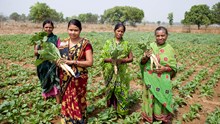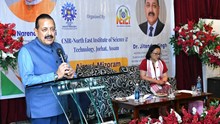
In the northeastern state of Assam, the arrival of spring is marked by a distinctive meteorological phenomenon known as Bordoisila. This pre-monsoon storm, characterized by sudden, intense winds, heavy rainfall, and thunderstorms, plays a vital role in shaping the region’s climate and culture. It not only marks the transition from the dry season to the monsoon but also holds deep cultural significance, intertwining nature’s fury with the joyous anticipation of Bohag Bihu, Assam's most celebrated festival.
Etymology and Cultural Significance
When I was young, preparations for Bohag Bihu would begin well in advance, often from the onset of April. Bihu workshops, bustling markets filled with festive outfits, and food shopping added to the excitement. However, amid these joyous moments, there was also a lingering concern—Bordoisila. The strong winds, followed by thunderstorms and heavy rains, would often wreak havoc on weaker buildings and agricultural fields. It was an inevitable part of the season, and I still remember my grandmother saying, "Bordoisila is in a hurry to go to her mother’s home for Bihu," before diving into her treasure trove of stories.
The term "Bordoisila" holds deep roots in Assamese folklore and language. Derived from the Bodo word "Bardoisikhla," it blends "Bar" (wind), "Doi" (water), and "Sikhla" (girl), representing a spirit goddess intertwined with nature’s elements. According to local legends, Bordoisila symbolizes a married woman returning to her maternal home during the month of Bohag, aligning with the grand celebrations of Rongali Bihu. Her hurried journey is believed to take the form of fierce winds and heavy rains, capturing the excitement and anticipation that surround the festive season.
Meteorological Characteristics
Bordoisila storms typically occur during the pre-monsoon months of April and May, a period marked by rising temperatures across the Indian subcontinent. As the sun shifts northward towards the Tropic of Cancer after the vernal equinox, regions like Assam experience temperatures ranging between 30°C and 35°C. This increase in temperature leads to low atmospheric pressure, creating conditions conducive to the formation of these storms.
The genesis of Bordoisila can be traced to the Chotanagpur Plateau, spanning parts of Bihar and Jharkhand. Here, the confluence of moist air incursion and elevated surface temperatures gives rise to violent thunderstorms. These storms gain momentum as they move southeastward, impacting states like Odisha, West Bengal, and Assam with gale-force winds, torrential rains, and occasional hailstorms. Wind speeds during these events often exceed 100 km/h, leading to significant environmental and infrastructural impacts.
Bordoisila’s Impact on Agriculture
The sudden onset of heavy rains and hail can damage standing crops, posing challenges for farmers. Conversely, these storms also provide much-needed rainfall that benefits certain Kharif crops like jute and paddy, aiding their growth and offering respite from pre-monsoon heat.
Beyond immediate impacts, these storms play a role in the broader climatic patterns of the region, contributing to the transition from the dry season to the monsoon period.
Bordoisila and Kalbaisakhi: Regional Variations
While Bordoisila is specific to Assam, similar pre-monsoon storms occur in other parts of eastern India and Bangladesh, known locally as Kalbaisakhi or "Nor'westers." The term "Kalbaisakhi" translates to "fateful thing of Baisakh," referring to the Bengali month during which these storms occur. Despite regional nomenclature differences, both phenomena share common meteorological origins and characteristics, including sudden thunderstorms, strong winds, and heavy rains, often accompanied by hail.
Adaptation and Preparedness
Given the recurring nature of Bordoisila, it is imperative for communities in Assam to adopt measures aimed at mitigating its adverse effects:
-
Early Warning Systems: Enhancing meteorological forecasting capabilities can provide timely alerts, allowing residents and authorities to prepare adequately for impending storms.
-
Infrastructure Resilience: Investing in robust infrastructure that can withstand high winds and heavy rainfall can reduce damage and associated costs.
-
Agricultural Strategies: Implementing crop diversification and adopting resilient farming practices can help mitigate agricultural losses due to sudden weather changes.
-
Community Awareness: Educating the public about Bordoisila, its characteristics, and safety measures can enhance community preparedness and response during storm events.
Bordoisila stands as a testament to the intricate interplay between nature and culture in Assam. This pre-monsoon storm, while posing challenges, also heralds the arrival of spring and the festive celebrations of Bohag Bihu. Understanding its origins, impacts, and the adaptive strategies employed by local communities offers valuable insights into the resilience and cultural richness of the region. As climate patterns evolve, continued research and preparedness will be essential in mitigating the effects of Bordoisila and safeguarding the livelihoods and traditions it influences.
















